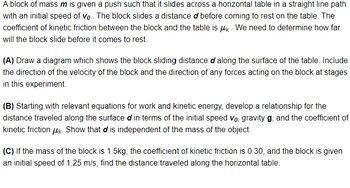
College Physics
11th Edition
ISBN: 9781305952300
Author: Raymond A. Serway, Chris Vuille
Publisher: Cengage Learning
expand_more
expand_more
format_list_bulleted
Topic Video
Question
PLEASE ANSWER ALL PARTS ASAP!!!!!

Transcribed Image Text:A block of mass m is given a push such that it slides across a horizontal table in a straight line path
with an initial speed of vo. The block slides a distance d before coming to rest on the table. The
coefficient of kinetic friction between the block and the table is k. We need to determine how far
will the block slide before it comes to rest.
(A) Draw a diagram which shows the block sliding distance d along the surface of the table. Include
the direction of the velocity of the block and the direction of any forces acting on the block at stages
in this experiment.
(B) Starting with relevant equations for work and kinetic energy, develop a relationship for the
distance traveled along the surface d in terms of the initial speed vo. gravity g, and the coefficient of
kinetic friction μk. Show that d is independent of the mass of the object.
(C) If the mass of the block is 1.5kg, the coefficient of kinetic friction is 0.30, and the block is given
an initial speed of 1.25 m/s, find the distance traveled along the horizontal table.
Expert Solution
This question has been solved!
Explore an expertly crafted, step-by-step solution for a thorough understanding of key concepts.
Step by stepSolved in 2 steps with 2 images

Knowledge Booster
Learn more about
Need a deep-dive on the concept behind this application? Look no further. Learn more about this topic, physics and related others by exploring similar questions and additional content below.Similar questions
- PLEASE ANSWER ALL PARTS!!!!!!!!!!! VERY URGENT!!!!!!!!!!arrow_forwardBrightness 250+ 450+ 800+ 1100+ 1600+ Standard 25W 40W 60W 75W 100W Assume your utility charges 5.5 cents per kWh, remember there are 100 cents in 1 dollar and 365 days in 1 year. With this info and the "how many lumens" chart, together with the data given in the tables on the next page you now have all the information to calculate your answers. Location Lumens per bulb Watts per bulb Total # of bulbs Total Watts Use: hours per day kWh per day Total kWh for 1 year Cost per 1 year Cost per 10 years Kitchen overhead 800 60 6 360 3 (360(3))/1000=1.08 394.2 $21.69 $216.90 Living room 1,600 100 3 300 4 (300(4))/1000=1.2 438 Dining Room 800 5 2arrow_forwardA car stereo pools 2.89 A from a car's battery. If the battery has a voltage of 12 V, how much power does it use? provide stepsarrow_forward
arrow_back_ios
SEE MORE QUESTIONS
arrow_forward_ios
Recommended textbooks for you
 College PhysicsPhysicsISBN:9781305952300Author:Raymond A. Serway, Chris VuillePublisher:Cengage Learning
College PhysicsPhysicsISBN:9781305952300Author:Raymond A. Serway, Chris VuillePublisher:Cengage Learning University Physics (14th Edition)PhysicsISBN:9780133969290Author:Hugh D. Young, Roger A. FreedmanPublisher:PEARSON
University Physics (14th Edition)PhysicsISBN:9780133969290Author:Hugh D. Young, Roger A. FreedmanPublisher:PEARSON Introduction To Quantum MechanicsPhysicsISBN:9781107189638Author:Griffiths, David J., Schroeter, Darrell F.Publisher:Cambridge University Press
Introduction To Quantum MechanicsPhysicsISBN:9781107189638Author:Griffiths, David J., Schroeter, Darrell F.Publisher:Cambridge University Press Physics for Scientists and EngineersPhysicsISBN:9781337553278Author:Raymond A. Serway, John W. JewettPublisher:Cengage Learning
Physics for Scientists and EngineersPhysicsISBN:9781337553278Author:Raymond A. Serway, John W. JewettPublisher:Cengage Learning Lecture- Tutorials for Introductory AstronomyPhysicsISBN:9780321820464Author:Edward E. Prather, Tim P. Slater, Jeff P. Adams, Gina BrissendenPublisher:Addison-Wesley
Lecture- Tutorials for Introductory AstronomyPhysicsISBN:9780321820464Author:Edward E. Prather, Tim P. Slater, Jeff P. Adams, Gina BrissendenPublisher:Addison-Wesley College Physics: A Strategic Approach (4th Editio...PhysicsISBN:9780134609034Author:Randall D. Knight (Professor Emeritus), Brian Jones, Stuart FieldPublisher:PEARSON
College Physics: A Strategic Approach (4th Editio...PhysicsISBN:9780134609034Author:Randall D. Knight (Professor Emeritus), Brian Jones, Stuart FieldPublisher:PEARSON

College Physics
Physics
ISBN:9781305952300
Author:Raymond A. Serway, Chris Vuille
Publisher:Cengage Learning

University Physics (14th Edition)
Physics
ISBN:9780133969290
Author:Hugh D. Young, Roger A. Freedman
Publisher:PEARSON

Introduction To Quantum Mechanics
Physics
ISBN:9781107189638
Author:Griffiths, David J., Schroeter, Darrell F.
Publisher:Cambridge University Press

Physics for Scientists and Engineers
Physics
ISBN:9781337553278
Author:Raymond A. Serway, John W. Jewett
Publisher:Cengage Learning

Lecture- Tutorials for Introductory Astronomy
Physics
ISBN:9780321820464
Author:Edward E. Prather, Tim P. Slater, Jeff P. Adams, Gina Brissenden
Publisher:Addison-Wesley

College Physics: A Strategic Approach (4th Editio...
Physics
ISBN:9780134609034
Author:Randall D. Knight (Professor Emeritus), Brian Jones, Stuart Field
Publisher:PEARSON